2019 FORD E SERIES child seat
[x] Cancel search: child seatPage 25 of 329
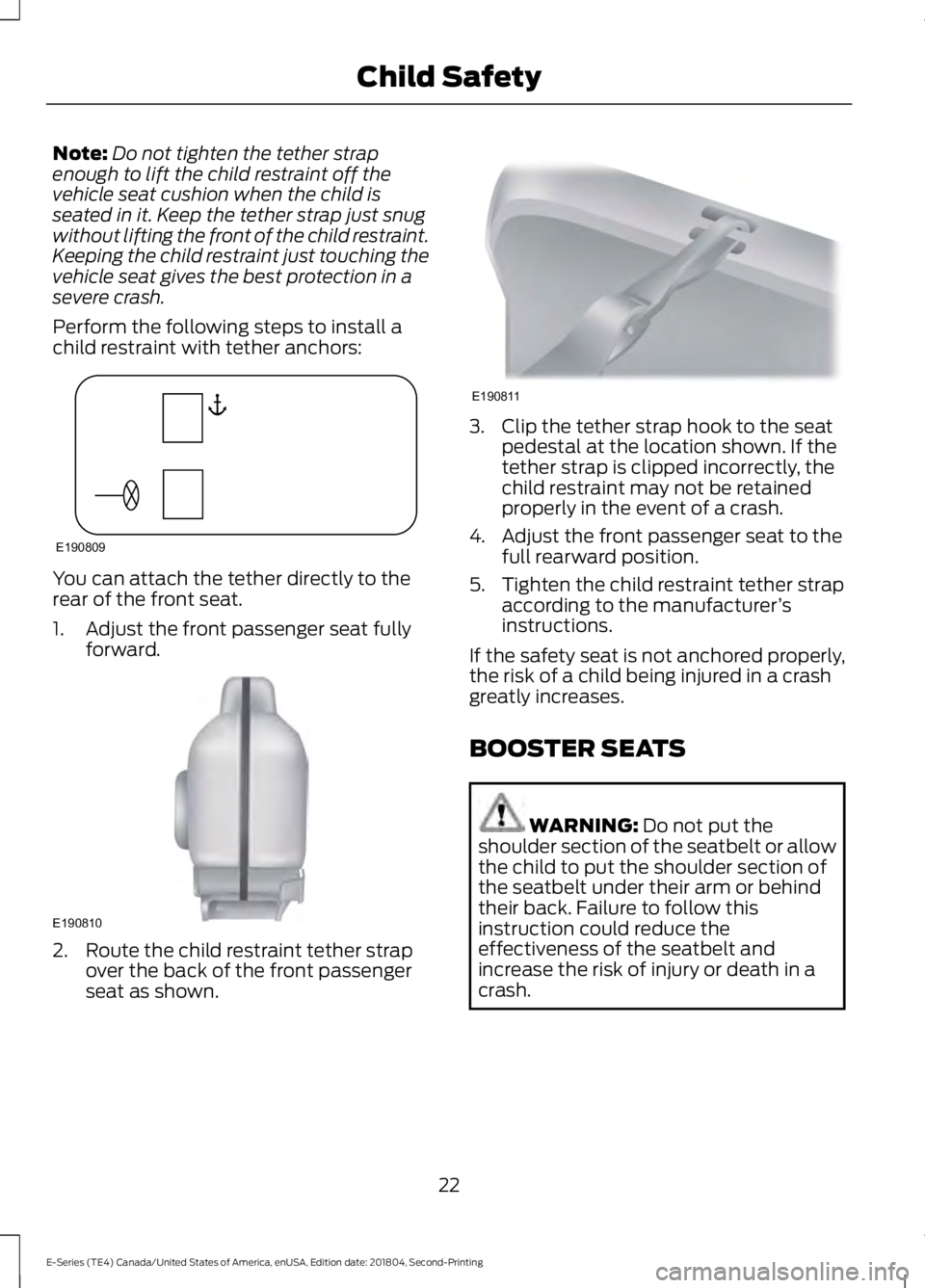
Note:Do not tighten the tether strapenough to lift the child restraint off thevehicle seat cushion when the child isseated in it. Keep the tether strap just snugwithout lifting the front of the child restraint.Keeping the child restraint just touching thevehicle seat gives the best protection in asevere crash.
Perform the following steps to install achild restraint with tether anchors:
You can attach the tether directly to therear of the front seat.
1. Adjust the front passenger seat fullyforward.
2. Route the child restraint tether strapover the back of the front passengerseat as shown.
3. Clip the tether strap hook to the seatpedestal at the location shown. If thetether strap is clipped incorrectly, thechild restraint may not be retainedproperly in the event of a crash.
4. Adjust the front passenger seat to thefull rearward position.
5. Tighten the child restraint tether strapaccording to the manufacturer’sinstructions.
If the safety seat is not anchored properly,the risk of a child being injured in a crashgreatly increases.
BOOSTER SEATS
WARNING: Do not put theshoulder section of the seatbelt or allowthe child to put the shoulder section ofthe seatbelt under their arm or behindtheir back. Failure to follow thisinstruction could reduce theeffectiveness of the seatbelt andincrease the risk of injury or death in acrash.
22
E-Series (TE4) Canada/United States of America, enUSA, Edition date: 201804, Second-Printing
Child SafetyE190809 E190810 E190811
Page 26 of 329
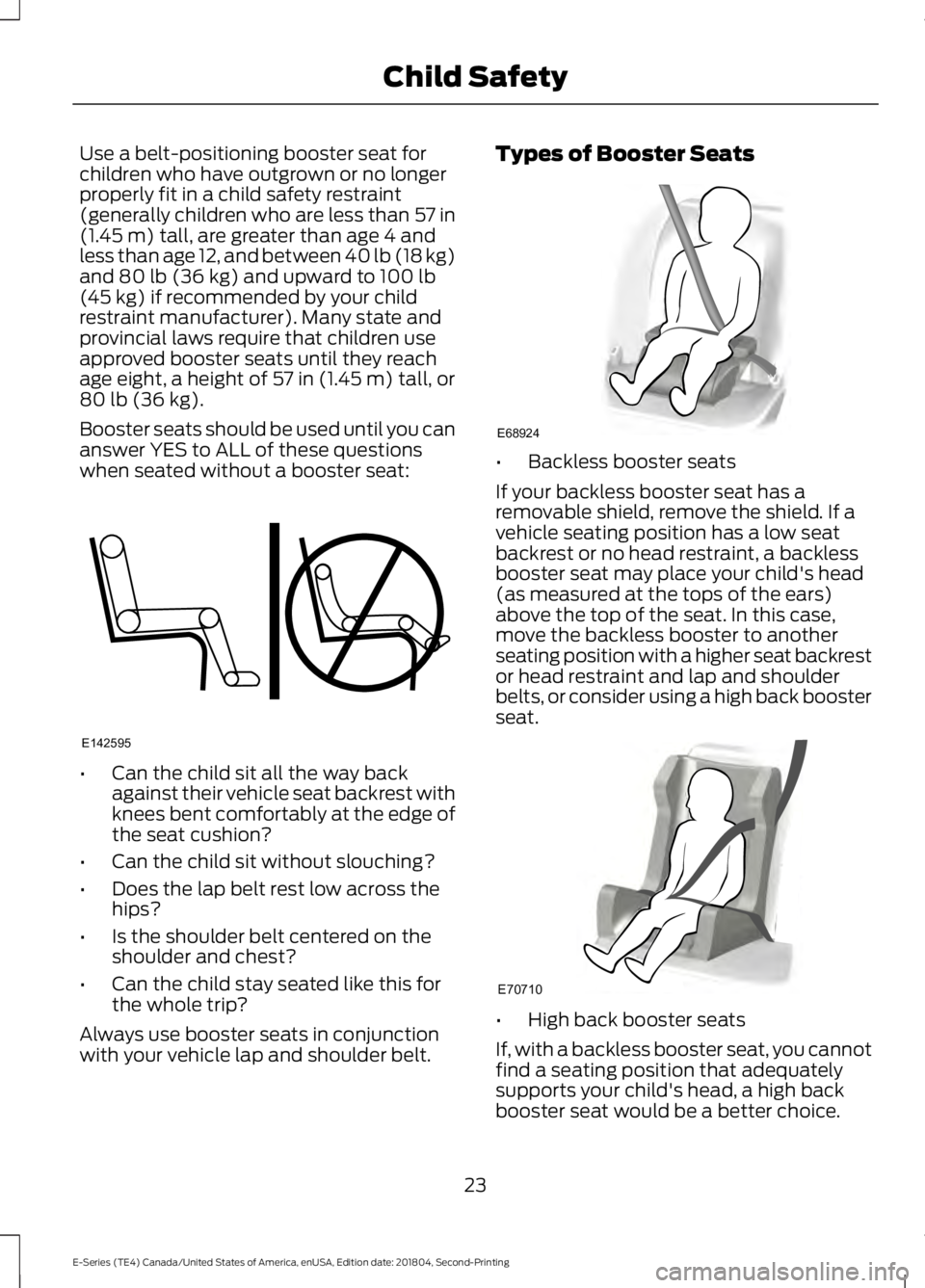
Use a belt-positioning booster seat forchildren who have outgrown or no longerproperly fit in a child safety restraint(generally children who are less than 57 in(1.45 m) tall, are greater than age 4 andless than age 12, and between 40 lb (18 kg)and 80 lb (36 kg) and upward to 100 lb(45 kg) if recommended by your childrestraint manufacturer). Many state andprovincial laws require that children useapproved booster seats until they reachage eight, a height of 57 in (1.45 m) tall, or80 lb (36 kg).
Booster seats should be used until you cananswer YES to ALL of these questionswhen seated without a booster seat:
•Can the child sit all the way backagainst their vehicle seat backrest withknees bent comfortably at the edge ofthe seat cushion?
•Can the child sit without slouching?
•Does the lap belt rest low across thehips?
•Is the shoulder belt centered on theshoulder and chest?
•Can the child stay seated like this forthe whole trip?
Always use booster seats in conjunctionwith your vehicle lap and shoulder belt.
Types of Booster Seats
•Backless booster seats
If your backless booster seat has aremovable shield, remove the shield. If avehicle seating position has a low seatbackrest or no head restraint, a backlessbooster seat may place your child's head(as measured at the tops of the ears)above the top of the seat. In this case,move the backless booster to anotherseating position with a higher seat backrestor head restraint and lap and shoulderbelts, or consider using a high back boosterseat.
•High back booster seats
If, with a backless booster seat, you cannotfind a seating position that adequatelysupports your child's head, a high backbooster seat would be a better choice.
23
E-Series (TE4) Canada/United States of America, enUSA, Edition date: 201804, Second-Printing
Child SafetyE142595 E68924 E70710
Page 27 of 329
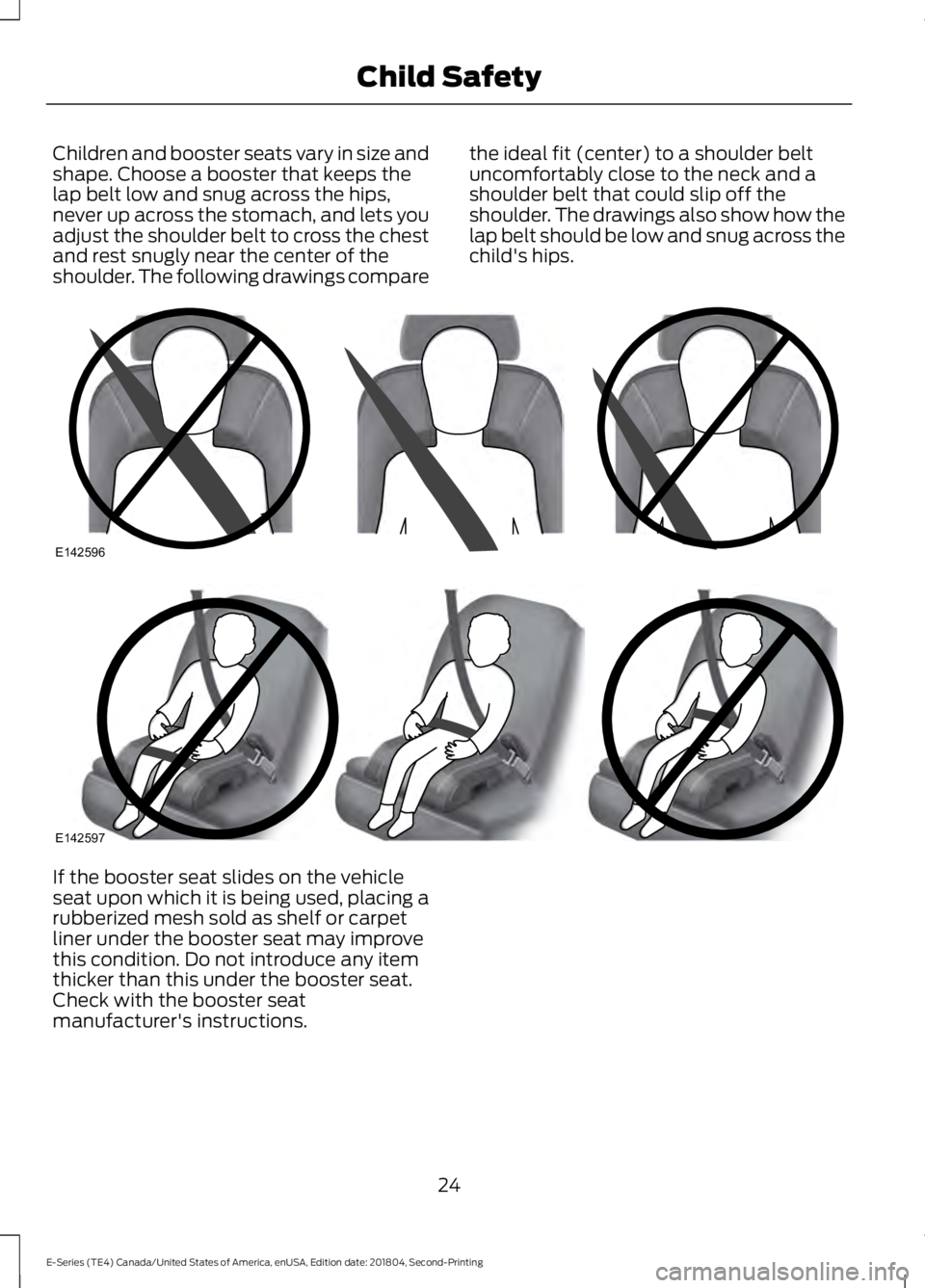
Children and booster seats vary in size andshape. Choose a booster that keeps thelap belt low and snug across the hips,never up across the stomach, and lets youadjust the shoulder belt to cross the chestand rest snugly near the center of theshoulder. The following drawings compare
the ideal fit (center) to a shoulder beltuncomfortably close to the neck and ashoulder belt that could slip off theshoulder. The drawings also show how thelap belt should be low and snug across thechild's hips.
If the booster seat slides on the vehicleseat upon which it is being used, placing arubberized mesh sold as shelf or carpetliner under the booster seat may improvethis condition. Do not introduce any itemthicker than this under the booster seat.Check with the booster seatmanufacturer's instructions.
24
E-Series (TE4) Canada/United States of America, enUSA, Edition date: 201804, Second-Printing
Child SafetyE142596 E142597
Page 28 of 329
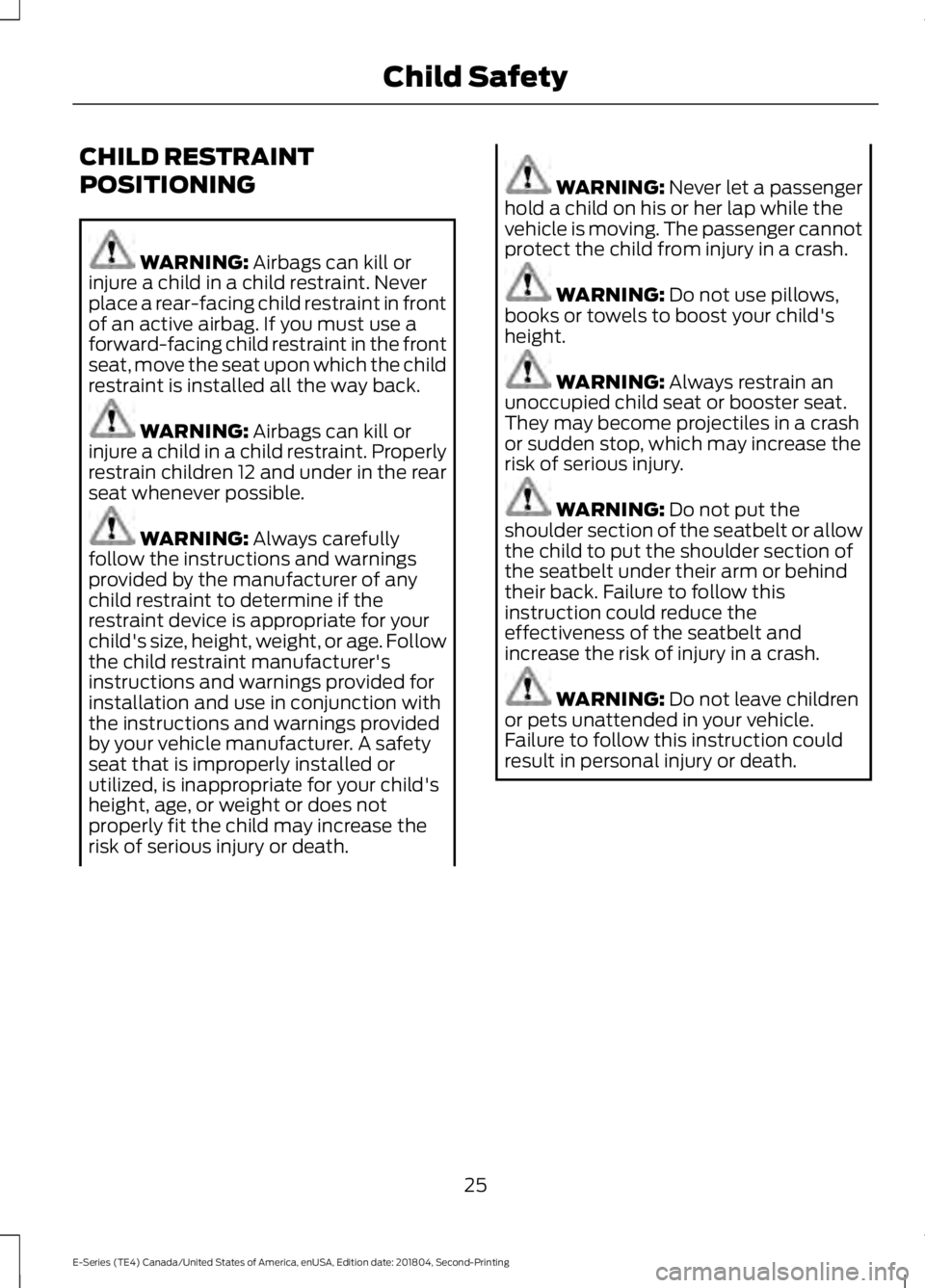
CHILD RESTRAINT
POSITIONING
WARNING: Airbags can kill orinjure a child in a child restraint. Neverplace a rear-facing child restraint in frontof an active airbag. If you must use aforward-facing child restraint in the frontseat, move the seat upon which the childrestraint is installed all the way back.
WARNING: Airbags can kill orinjure a child in a child restraint. Properlyrestrain children 12 and under in the rearseat whenever possible.
WARNING: Always carefullyfollow the instructions and warningsprovided by the manufacturer of anychild restraint to determine if therestraint device is appropriate for yourchild's size, height, weight, or age. Followthe child restraint manufacturer'sinstructions and warnings provided forinstallation and use in conjunction withthe instructions and warnings providedby your vehicle manufacturer. A safetyseat that is improperly installed orutilized, is inappropriate for your child'sheight, age, or weight or does notproperly fit the child may increase therisk of serious injury or death.
WARNING: Never let a passengerhold a child on his or her lap while thevehicle is moving. The passenger cannotprotect the child from injury in a crash.
WARNING: Do not use pillows,books or towels to boost your child'sheight.
WARNING: Always restrain anunoccupied child seat or booster seat.They may become projectiles in a crashor sudden stop, which may increase therisk of serious injury.
WARNING: Do not put theshoulder section of the seatbelt or allowthe child to put the shoulder section ofthe seatbelt under their arm or behindtheir back. Failure to follow thisinstruction could reduce theeffectiveness of the seatbelt andincrease the risk of injury in a crash.
WARNING: Do not leave childrenor pets unattended in your vehicle.Failure to follow this instruction couldresult in personal injury or death.
25
E-Series (TE4) Canada/United States of America, enUSA, Edition date: 201804, Second-Printing
Child Safety
Page 29 of 329

Recommendations for attaching child safety restraints for children
Use Any Attachment Method as Indicated Below by X.
Restraint TypeSeatbelt OnlySeatbelt and TopTether Anchor
Combined Weight ofChild and ChildRestraint
Up to 65 lb (29.5 kg)Rear-facingchild restraint
Over 65 lb (29.5 kg)Rear-facingchild restraint
X1XUp to 65 lb (29.5 kg)Forward-facingchild restraint
X1XOver 65 lb (29.5 kg)Forward-facingchild restraint
1 We recommend using a top tether if the child restraint has one, and the child restraintmanufacturer recommends its use.
Note:The child restraint must rest tightlyagainst the vehicle seat upon which it isinstalled. It may be necessary to lift orremove the head restraint. See HeadRestraints (page 69).
26
E-Series (TE4) Canada/United States of America, enUSA, Edition date: 201804, Second-Printing
Child Safety
Page 30 of 329

PRINCIPLE OF OPERATION
WARNING: Always drive and ridewith the seat backrest upright and thelap belt snug and low across the hips.
WARNING: To reduce the risk ofinjury, make sure children sit where theycan be properly restrained.
WARNING: Never let a passengerhold a child on his or her lap while yourvehicle is moving. The passenger cannotprotect the child from injury in a crashwhich may result in serious injury ordeath.
WARNING: All occupants of thevehicle, including the driver, shouldalways properly wear their safety belts,even when an airbag supplementalrestraint system is provided. Failure toproperly wear your safety belt couldseriously increase the risk of injury ordeath.
WARNING: It is extremelydangerous to ride in a cargo area, insideor outside of a vehicle. In a crash, peopleriding in these areas are more likely to beseriously injured or killed. Do not allowpeople to ride in any area of your vehiclethat is not equipped with seats andsafety belts. Be sure everyone in yourvehicle is in a seat and using a safety beltproperly.
WARNING: In a rollover crash, anunbelted person is significantly morelikely to die than a person wearing asafety belt.
WARNING: Each seating positionin your vehicle has a specific safety beltassembly which is made up of onebuckle and one tongue that are designedto be used as a pair. 1) Use the shoulderbelt on the outside shoulder only. Neverwear the shoulder belt under the arm. 2)Never swing the safety belt around yourneck over the inside shoulder. 3) Neveruse a single belt for more than oneperson.
WARNING: When possible, allchildren 12 years old and under shouldbe properly restrained in a rear seatingposition. Failure to follow this couldseriously increase the risk of injury ordeath.
WARNING: Safety belts and seatscan become hot in a vehicle that hasbeen closed up in sunny weather; theycould burn a small child. Check seatcovers and buckles before you place achild anywhere near them.
WARNING: Front and rear seatoccupants, including pregnant women,should wear safety belts for optimumprotection in an accident.
All seating positions in this vehicle havelap and shoulder safety belts. Alloccupants of the vehicle should alwaysproperly wear their safety belts, even whenan airbag supplemental restraint systemis provided.
The safety belt system consists of:
•Lap and shoulder safety belts.
•Shoulder safety belt with automaticlocking mode, (except driver safetybelt).
27
E-Series (TE4) Canada/United States of America, enUSA, Edition date: 201804, Second-Printing
Seatbelts
Page 32 of 329

Pregnant women should always wear theirseatbelt. Position the lap belt portion of acombination lap and shoulder belt lowacross the hips below the belly and wornas tight as comfort allows. Position theshoulder belt to cross the middle of theshoulder and the center of the chest.
Seatbelt Locking Modes
WARNING: If your vehicle isinvolved in a crash, have the seatbeltsand associated components inspectedas soon as possible. Failure to follow thisinstruction could result in personal injuryor death.
All safety restraints in the vehicle arecombination lap and shoulder belts. Thedriver seatbelt has the first type of lockingmode. The front outboard passengerseatbelt has both types of locking modesdescribed as follows:
Vehicle Sensitive Mode
This is the normal retractor mode, whichallows free shoulder belt lengthadjustment to your movements andlocking in response to vehicle movement.For example, if the driver brakes suddenlyor turns a corner sharply, or the vehiclereceives an impact of about 5 mph(8 km/h) or more, the combinationseatbelts lock to help reduce forwardmovement of the driver and passengers.
In addition, the retractor is designed to lockif you pull the webbing out too quickly. Ifthe seatbelt retractor locks, slowly lowerthe height adjuster to allow the seatbeltto retract. If the retractor does not unlock,pull the seatbelt out slowly then feed a
small length of webbing back toward thestowed position. For rear seatbelts, reclinethe rear seat backrest or push the seatbackrest cushion away from the seatbelt.Feed a small length of webbing backtoward the stowed position.
Automatic Locking Mode
In this mode, the shoulder beltautomatically pre-locks. The belt will stillretract to remove any slack in the shoulderbelt. The automatic locking mode is notavailable on the driver seatbelt.
When to Use the Automatic LockingMode
Use this mode any time a child safety seat,except a booster, is installed in thepassenger front seating position. SeeChild Safety (page 17).
How to Use the Automatic LockingMode
1. Buckle the combination lap andshoulder belt.
2. Grasp the shoulder portion and pulldownward until the entire belt is pulledout.
3. Allow the belt to retract. As the beltretracts, you will hear a clicking sound.This indicates the seatbelt is now in theautomatic locking mode.
29
E-Series (TE4) Canada/United States of America, enUSA, Edition date: 201804, Second-Printing
SeatbeltsE142591
Page 34 of 329
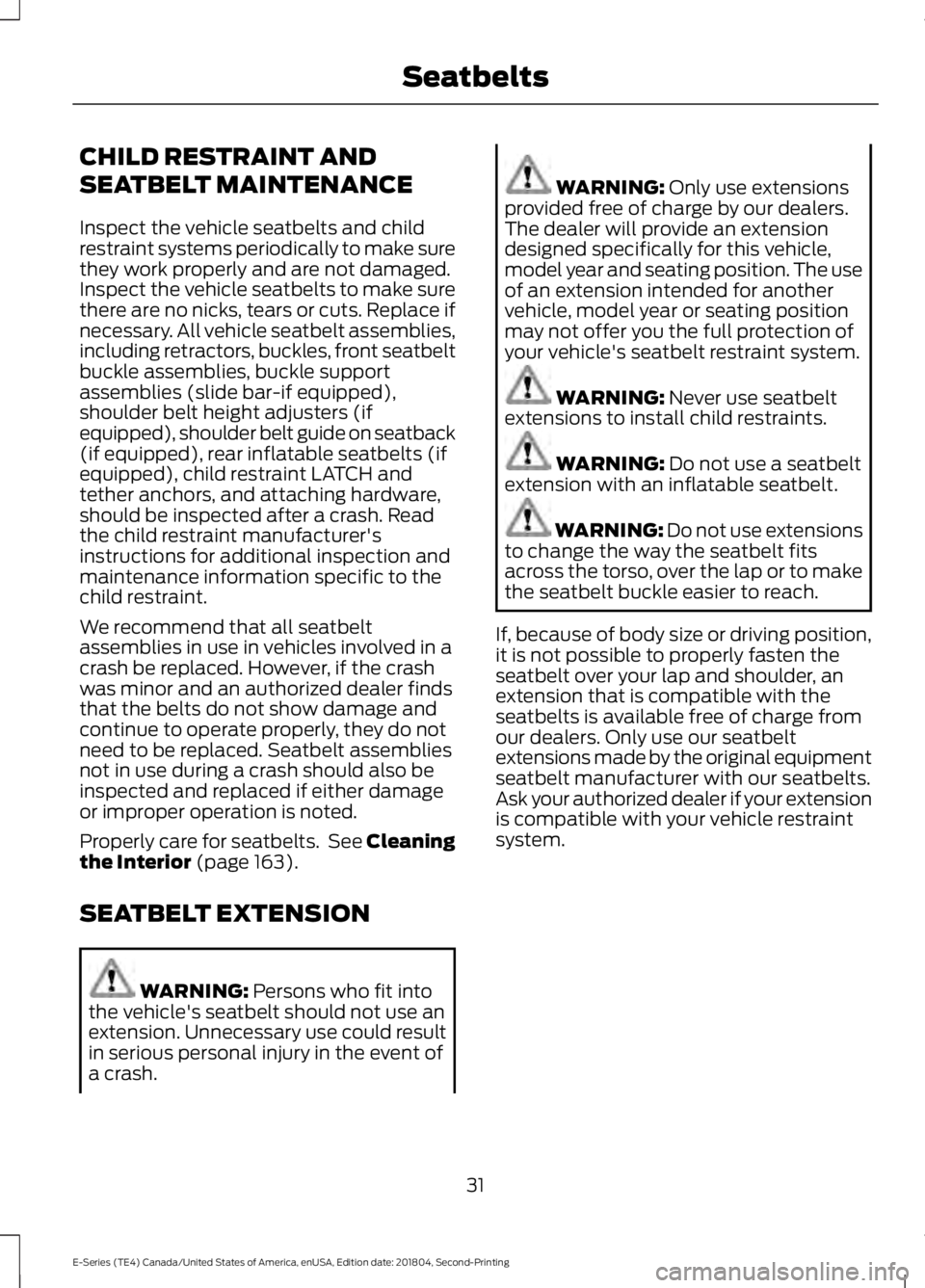
CHILD RESTRAINT AND
SEATBELT MAINTENANCE
Inspect the vehicle seatbelts and childrestraint systems periodically to make surethey work properly and are not damaged.Inspect the vehicle seatbelts to make surethere are no nicks, tears or cuts. Replace ifnecessary. All vehicle seatbelt assemblies,including retractors, buckles, front seatbeltbuckle assemblies, buckle supportassemblies (slide bar-if equipped),shoulder belt height adjusters (ifequipped), shoulder belt guide on seatback(if equipped), rear inflatable seatbelts (ifequipped), child restraint LATCH andtether anchors, and attaching hardware,should be inspected after a crash. Readthe child restraint manufacturer'sinstructions for additional inspection andmaintenance information specific to thechild restraint.
We recommend that all seatbeltassemblies in use in vehicles involved in acrash be replaced. However, if the crashwas minor and an authorized dealer findsthat the belts do not show damage andcontinue to operate properly, they do notneed to be replaced. Seatbelt assembliesnot in use during a crash should also beinspected and replaced if either damageor improper operation is noted.
Properly care for seatbelts. See Cleaningthe Interior (page 163).
SEATBELT EXTENSION
WARNING: Persons who fit intothe vehicle's seatbelt should not use anextension. Unnecessary use could resultin serious personal injury in the event ofa crash.
WARNING: Only use extensionsprovided free of charge by our dealers.The dealer will provide an extensiondesigned specifically for this vehicle,model year and seating position. The useof an extension intended for anothervehicle, model year or seating positionmay not offer you the full protection ofyour vehicle's seatbelt restraint system.
WARNING: Never use seatbeltextensions to install child restraints.
WARNING: Do not use a seatbeltextension with an inflatable seatbelt.
WARNING: Do not use extensionsto change the way the seatbelt fitsacross the torso, over the lap or to makethe seatbelt buckle easier to reach.
If, because of body size or driving position,it is not possible to properly fasten theseatbelt over your lap and shoulder, anextension that is compatible with theseatbelts is available free of charge fromour dealers. Only use our seatbeltextensions made by the original equipmentseatbelt manufacturer with our seatbelts.Ask your authorized dealer if your extensionis compatible with your vehicle restraintsystem.
31
E-Series (TE4) Canada/United States of America, enUSA, Edition date: 201804, Second-Printing
Seatbelts